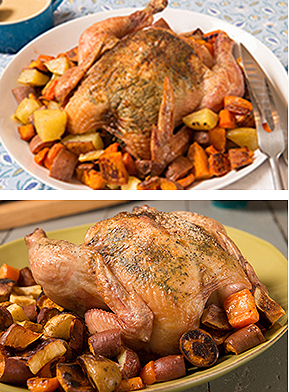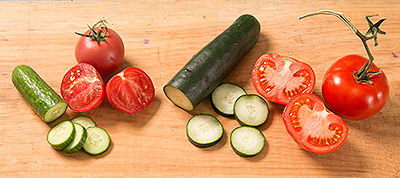In today’s everything-old-is-new-again food culture, it’s a virtue to shop at the farmers market. As many of us embrace the time- and labor-intensive practices our grandparents happily gave up – baking bread, canning vegetables – buying as much of our food as possible from the people who raised, grew, or made it is something we aspire to. It makes us feel good to know that what we eat hasn’t come from a factory farm, hundreds, or thousands, of petroleum-fueled miles away. But it’s not always practical.
Like many people, I enjoy the sensory and community-minded experience of shopping at the farmers market. In the warmer months, the Wednesday Monument Square market is just outside my office, making it easy to load up on fresh vegetables, fruit, eggs and maybe a chicken to roast. But I don’t often get to the Deering Oaks park market on Saturdays and stopped into the indoor market at Urban Farm Fermentory on just a handful of occasions this winter.
Why? Because although eating locally sourced, wholesome food is important to me, I have a job, family and other demands on my time. There’s usually a number of items on my shopping list that aren’t available at the farmers market: toilet paper; laundry detergent; chocolate chips. In addition, our household budget is tight and the lure of seasonal produce makes it easy to overbuy.
For the majority of us, the supermarket is a reality – and we are grateful for the convenience and quality of our local grocers. But the approach of opening day for the outdoor farmers market in Portland hatched an idea: to compare the experience of shopping for a simple meal at the farmers market and at Shaw’s – the second-largest supermarket chain in Maine, after Hannaford. I chose Shaw’s because it has its origins in Portland, where George C. Shaw opened a teashop in 1862. The menu: herb-butter roast chicken; roasted vegetables with tahini dressing; baby greens salad with tomato and cucumber; honey-vanilla cream for dessert.
THE FARMERS MARKET
It’s a raw, gray day for the inaugural 2014 outdoors farmers market on April 26. Eager early shoppers in Deering Oaks park have only a chill wind to contend with; drenching rain would come later. The atmosphere is nonetheless festive, with both farmers and their customers happy to be back outside.
I roam from stall to stall, re-familiarizing myself with the available offerings before making any purchases. As often happens at the farmers market, I encounter friends – Chris Kast and his husband, Byron Bartlett, their dog in tow, shopping for Kast’s birthday dinner.
At the Olivia’s Garden stall, I chat with owner Scott Howard, Olivia’s dad, who explains that his Sweet Pink tomatoes go by the official name of Tomimaru Muchoo, the small cucumbers are an early European variety and that the bag of salad I’ve chosen is a mix of baby greens including tatsoi, pak choi, Swiss chard, two types of kale and radish.
I greet Doug Donahue, a familiar face at the Balfour Farm stall. Since it’s too early for summer fruit, the dessert I’ve planned is dairy-based. Donohue explains that his herd of milkers is half Jerseys, known for their high butterfat content, and half Normandies, whose milk is high in protein. I buy a quart of raw milk, a small tub of organic butter and a dozen eggs.
At the next stand, Andrea Bachelder of Tom’s Honey is bundled in a buffalo-plaid wool jacket against the cold. She tells me that the small jar of light-colored honey I choose is a mild, sweet, wildflower blend, which will be perfect for the dessert.
There’s a line at the Maine-ly Poultry table, and as I wait, aware that the woven bag on my shoulder is growing uncomfortably heavy, I’m envious of the parents with kids in strollers, who have a place to stow their purchases. I hear Peter Egan, the jovial guy who’s manning the stand, tell the couple in front of me that the whole chickens are small, about three pounds. That’s just fine with me, since I’ll be cooking another one, from Shaw’s, too.
My final stop is Goranson Farm’s stall, where helper Emily Eschner takes my money for a bag of assorted root vegetables and two bunches of fresh herbs – sage and thyme – for the herb butter I will stuff under the chicken’s skin. Shivering in my spring jacket, I schlep my purchases back to the car; the whole experience having taken about 30 minutes. I’ve spent $45.45.
THE SUPERMARKET
The rain has already begun when we pull into the parking lot at Shaw’s in Westbrook. Inside, I’m instantly grateful for the warmth and the ease of pushing a cart. In the brightly lit, well-stocked produce section, unfamiliar because it’s my first time here, I wander around for a few minutes to get my bearings before putting anything in my cart. I choose a plastic clamshell container of Earthbound Farm organic spring mix, two bright red tomatoes-on-the-vine from Maine’s Backyard Farms, a dark green-skinned cucumber, organic herbs in plastic boxes, a bag of parsnips and another of Earthbound Farm organic carrots, a sweet potato and a few Yukon Gold potatoes. The Earthbound Farms produce is from California and the bag of parsnips is marked Canada; the cucumber, herbs and potatoes are of indeterminate origin.
This Shaw’s has a butcher counter, but it’s not staffed and the meat is all wrapped in packages. It’s a nice surprise to find the chain’s private brand – Wild Harvest – in the poultry case. The whole chickens aren’t organic; they’re “natural,” which Shaw’s defines on its website as “products produced without artificial colors, flavors or preservatives.” The label on the packaged chicken says it has been “minimally processed,” has been given 100 percent vegetarian feed and no antibiotics.
If price is the only concern, it’s obviously much less expensive to shop at the supermarket than the farmers market. But since my goal is to compare the two shopping, cooking and eating experiences as a whole, it’s important that my food choices at Shaw’s match as closely as possible the rest of what I purchased in Deering Oaks park. I’m therefore glad to find Wild Harvest organic in other departments; the brand’s whole milk, butter, eggs and honey finish my list.
Because I don’t know the layout of the store, it takes me a few tries down the aisles to locate the honey; I finally locate a helpful employee who points me in the right direction. The young woman at checkout is exceptionally friendly, suggesting I take the customer satisfaction survey for a chance to win a $100 Shaw’s gift card. I’ve spent about 15 minutes and $39.72 (the chicken and butter were on sale, otherwise the total would have been $42.84).
THE MEAL
How a chicken is raised and what it is fed directly affects its flavor, so this is where I expected to find the most pronounced difference between the farmers market and supermarket dinners. The two birds were close in size – 3.63 pounds for Maine-ly Poultry and 4.22 pounds for Shaw’s – so I roasted them at the same time, putting the Shaw’s chicken in the oven about 15 minutes ahead of the smaller roaster.
Bolstered by the herb butter stuffed under the breast skin – plus liberal seasoning with kosher salt and freshly ground pepper – both chickens had excellent flavor, although the Maine-ly Poultry bird was slightly more “chicken-y” and the meat was firmer. Checking the two labels, I saw that the Shaw’s chicken contained up to 5 percent water; the Maine-ly Poultry chicken contained just up to 3 percent, which could explain the textural difference.
Of the roasted vegetables, only the carrots varied; the Goranson Farm organic carrots, grown in Dresden, were far sweeter than the Earthbound Farm organic carrots from California, purchased at Shaw’s. There was no discernible taste and texture difference between the local potatoes and parsnips and those from the supermarket.
The Olivia’s Garden salad greens – grown in Maine – had a more distinct, peppery and earthy flavor than the Earthbound Farm greens, but the variation may have been due to the type of greens included in the mix. Olivia’s blend focused on baby Asian greens; the Earthbound Farm package contained a variety of organic baby lettuces, mizuna, red and green chard, spinach, arugula, frisee and radicchio.
Unlike the sweet, crispy Olivia’s Garden cucumber, which could be munched whole, the skin of the supermarket cucumber was exceptionally bitter so required peeling. And while the Backyard Farms tomatoes purchased at Shaw’s were good for out-of-season, the juicy, firm, aptly named Sweet Pinks from Olivia’s were a clear reminder that tomatoes are, in fact, fruit.
The two versions of honey-vanilla cream differed wildly in both taste and texture. Raw milk, eggs and honey from the farmers market produced a custard that was smooth and creamy, with delicate honey flavor. Although the preparation method was identical – and I am an experienced cook – the honey-vanilla cream made from the supermarket ingredients was slightly curdled, but still tasty. The Shaw’s honey, from Brazil, had a stronger flavor, not my favorite but something serious honey-lovers might enjoy.
I came away from this shopping and cooking experiment not altogether surprised at the outcome. I spent nearly the same, in total, at each location, yet my money went further at Shaw’s; everything I bought was simply bigger. With the exception of the dessert, which was identical for each, the farmers market meal would have served four people; the Shaw’s meal could have served 6 or 7.
If time, budget – and let’s be honest, weather – allow, the outdoor environment and personal interaction at the farmers market makes shopping more fun than a chore (although you do have to lug what you buy). Local, seasonal, fresh and unprocessed is always best, but at least here in Portland, it’s nice to know that the supermarket is not anathema to eating healthfully and well.
Contact Susan Axelrod at 791-6310 or at:
saxelrod@mainetoday.com
Send questions/comments to the editors.








Comments are no longer available on this story